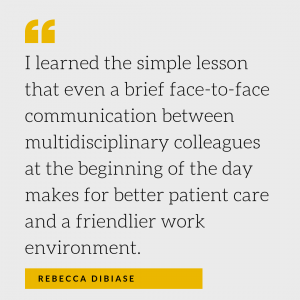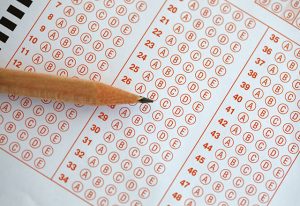 At the end of May, I finished graduate school and resumed medical school. Returning to clinical rotations with a fresh perspective, I have been able to more clearly reflect on the many lessons we learn from everyday interactions with patients, caregivers and colleagues. I would like to share a few valuable lessons.
At the end of May, I finished graduate school and resumed medical school. Returning to clinical rotations with a fresh perspective, I have been able to more clearly reflect on the many lessons we learn from everyday interactions with patients, caregivers and colleagues. I would like to share a few valuable lessons.
My first rotation back was on the neurology service. Throughout my time here, a theme arose that I found myself continually reflecting upon. Many neurologic conditions involve not only the brain and nervous system, but also many other organ systems. A patient’s neurologic symptoms may often be the first step in diagnosis of a cancer, autoimmune disorder, infection or psychiatric condition. As our team evaluated each new patient, we would strive to identify one unifying diagnosis that would tie all the symptoms together. A patient with cough, fatigue, weight loss and a headache could have a new diagnosis of HIV, tuberculosis or cancer. However, the patient could also be a stressed-out medical student with seasonal allergies.
 Though this is an exaggerated example, it illustrates an important lesson embedded in the art of medicine. One of the attending physicians I worked with would frequently tell us “Physicians seek diagnostic parsimony.” The exams we take in medical school present patient cases similar to the example above, and students must choose the best answer (A, B, C or D). However, in real practice, this model is usually unrealistic. Thus, physicians must employ a multifaceted approach that simultaneously evaluates the patient as a whole and each symptom in isolation. In learning this lesson, I came to appreciate this challenge facing every training physician.
Though this is an exaggerated example, it illustrates an important lesson embedded in the art of medicine. One of the attending physicians I worked with would frequently tell us “Physicians seek diagnostic parsimony.” The exams we take in medical school present patient cases similar to the example above, and students must choose the best answer (A, B, C or D). However, in real practice, this model is usually unrealistic. Thus, physicians must employ a multifaceted approach that simultaneously evaluates the patient as a whole and each symptom in isolation. In learning this lesson, I came to appreciate this challenge facing every training physician.
After neurology, I completed an internal medicine rotation at Johns Hopkins Bayview. On the internal medicine service, not only are patients very medically complicated, but they also often have challenging social needs. Caring for them means addressing both the medical and socioeconomic barriers inhibiting them from remaining healthy. In striving to do this, I worked with a number of different practitioners, including physician specialists, nurses, physical therapists, occupational therapists, pharmacists, nutritionists and social workers.

It was through this multidisciplinary approach that I truly grasped the importance of face-to-face communication and names. Initially, when I needed to communicate with one of the nurses on our team, I would give him or her a quick phone call. One day by chance I bumped into a nurse in the hallway with whom I had been previously speaking over the phone. Despite the fact that I walked past this nurse multiple times daily, neither of us had realized that we were the same people who had been speaking with one another via telephone all day. There was a tangible difference in quality of care for the patient after this. In addition, in the case of this particular nurse, I also made a new friend. I learned the simple lesson that even a brief face-to-face communication between multidisciplinary colleagues at the beginning of the day makes for better patient care and a friendlier work environment.
I am currently working on the chronic pain psychiatry service. One aspect of this rotation I have enjoyed is the opportunity to observe and help facilitate therapy sessions.
 During one group session, we talked about the correlation between pain and mood. The group facilitator emphasized interconnection between the two. During times of extreme anxiousness or depression, people tend to perceive pain as more overwhelming and debilitating. The group also talked about the utility of schedules and checklists to help manage anxiety.
During one group session, we talked about the correlation between pain and mood. The group facilitator emphasized interconnection between the two. During times of extreme anxiousness or depression, people tend to perceive pain as more overwhelming and debilitating. The group also talked about the utility of schedules and checklists to help manage anxiety.
As I was about to head to bed that night, I reflected on the group session. Recently, despite my attempts to readjust my desk chair height and switch pillows on my bed, my neck had been persistently sore. Simultaneously, my stress level over the upcoming residency application period and everything I need to accomplish in the meantime had been steadily rising. I opened a new “Sticky Note” on my computer and typed a list of every task. When I woke up the next morning, I completed the first two tasks and deleted them from the list. That evening, I completed and deleted the third task. When I woke up the next day, my neck was feeling remarkably better, through no intervention other than simply listening to advice. Through this experience, I learned how clinical care can be a healing and learning experience in two directions.
These are only three of the many overarching lessons I have learned from my time on the wards. Additionally, simply writing this post taught me the value of ongoing self-reflection as my training continues.
Want to read more from the Johns Hopkins School of Medicine? Subscribe to the Biomedical Odyssey blog and receive new posts directly in your inbox.
